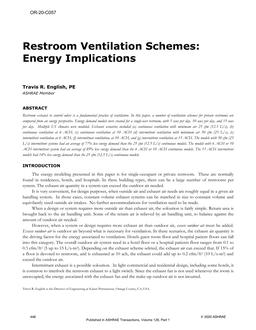Click here to purchase
Restroom exhaust to control odors is a fundamental practice of ventilation. In this paper, a number of ventilation schemes for private restrooms are compared from an energy perspective. Energy demand models were created for a single-user restroom, with 5 uses per day. 10 uses per day, and 15 uses per day. Multiple US climates were modeled. Exhaust scenarios included (a) continuous ventilation with minimum air 25 cfm (12.5 L/s), (b) continuous ventilation at 6 ACH, (c) continuous ventilation at 10 ACH (d) intermittent ventilation with minimum air 50 cfm (25 L/s), (e) intermittent ventilation at 6 ACH, (f) intermittnat ventilation, at 10 ACH, and (g) intermittent ventilation at 15 ACH. The models with 50 cfm (25 L/s) intermittent systems had an average of 77% less energy demand than the 25 cfm (12.5 L/s) continuous models. The models with 6 ACH or 10 ACH intermittent system had an average of 89% less energy demand than the 6 ACH or 10 ACH continuous models. The 15 ACH intermittent models had 14% less energy demand than the 25 cfm (12.5 L/s) continuous models.
Citation: 2020 Winter Conference, Orlando, FL Conference Papers
Product Details
- Published:
- 2020
- Number of Pages:
- 8
- Units of Measure:
- Dual
- File Size:
- 1 file , 2.2 MB
- Product Code(s):
- D-OR-20-C057
